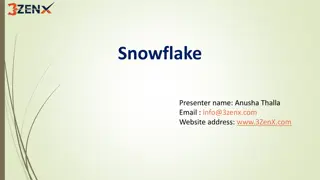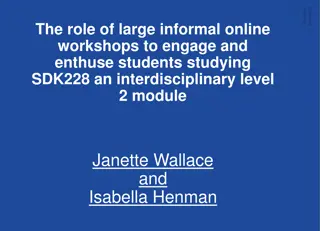Effective Use of Data in Professional Learning Workshops
Explore the significance of data in education through workshops focusing on defining data, understanding evidence, and utilizing data for decision-making. Discover the impact of big and small data, data bias, and limitations, while reflecting on data usage in educational settings.
Download Presentation

Please find below an Image/Link to download the presentation.
The content on the website is provided AS IS for your information and personal use only. It may not be sold, licensed, or shared on other websites without obtaining consent from the author.If you encounter any issues during the download, it is possible that the publisher has removed the file from their server.
You are allowed to download the files provided on this website for personal or commercial use, subject to the condition that they are used lawfully. All files are the property of their respective owners.
The content on the website is provided AS IS for your information and personal use only. It may not be sold, licensed, or shared on other websites without obtaining consent from the author.
E N D
Presentation Transcript
Effective use of data Effective use of data 1. Establishing the purpose and use of data Practitioners
The national model of professional learning The national model of professional learning The national model of professional learning | Professional Learning | Education Scotland
Draft agreement and protocols Draft agreement and protocols We all work together We learn from, with and on behalf of each other We create a safe space to share ideas and build learning We agree that everyone is an equal and valued participant We remain in the room (follow email and phone protocol)
Connector Connector In groups or pairs: Agree on something you all like Agree on something you all dislike. TASK
Aims Aims In this workshop we will consider: the meaning of data and evidence in education what guidance and research says about the importance of data and evidence how data and evidence can inform our decision- making the difference between big and small data.
Content coverage Data definitions and the bigger picture National guidance and research The purpose of using data Big and small data Data bias and limitations Impact of data Reflections
Data as we know it Discuss all the different things that you think could be classed as data within your classroom/setting. TASK Make a list.
What is data? Educational data is any information, textual or numerical, that can be used in a systematic way to inform educational practice. The Evidence Institute
What is evidence? "Evidence can be described as information used to demonstrate impact and support decision making. Evidence can be data, in many forms, and a knowledge base about what works." Rapid Evidence Review
Types of data quantitative and qualitative TalkingPoint Data can be split into two main categories: Qualitative Quantitative Deals with information that can be counted or measured Data which can be given a numerical value Deals with descriptions Data that can be observed and recorded but not necessarily measured Can you think of examples of where you use quantitative or qualitative data in your classroom or school?
What do we mean by data? Defining data : Different people have different definitions of data: For some, data means only numerical data For others, data means all evidence and information When thinking about data use in education, it can be helpful to define data as information that has been systematically collected in some way, as this helps differentiate data from professional judgements or opinions.
The bigger picture Being clear about what type of information we are using and why helps us to think about what we know and what we don t know. Formal Research Big Data (formal) Practitioner Research Small Data (informal) Each way of knowing has its own advantages and disadvantages, and we should aim to avoid making significant decisions based on solely one element. Professional Judgement Model adapted from Van Lommel Teachers decision-making: Data based or intuition driven? | Request PDF (researchgate.net)
TalkingPoint The bigger picture part 1 Formal Research Big Data (formal) Practitioner Research Small Data (informal) Professional Judgement
The bigger picture part 2 Big Data (formal) Formal Research Small Data (informal) Practitioner Research Professional Judgement
The bigger picture part 3 Formal Research Big Data (formal) Practitioner Research Small Data (informal) Professional Judgement
The National Improvement Framework Where progress is good or better, senior leaders and staff track children s and young people s progress carefully. They use assessment information and data effectively to understand the progress children and young people make. Achieving Excellence and Equity - 2024 National Improvement Framework and Improvement Plan (www.gov.scot)
GTCS Standards for Full Registration and Career Long Professional Learning Curriculum and Pedagogy 3.1.1 - Plan effectively to meet learners needs 3.1.4 - Effectively employ assessment, evaluate progress, recording and reporting as an integral part of the teaching process to support and enhance learning. Professional Learning 3.3.2 - Engage in reflective practice to develop and advance career-long professional learning. GTCS The Standard for Full Registration GTCS - The Standard for Career-Long Professional Learning
HGIOS 4 Staff make effective use of current available data on levels of child poverty and apply this to ensure equity (1.5) All teachers have well-developed skills of data analysis which are focused on improvement (2.3) We use data to evaluate the effectiveness of interventions designed to improve outcomes for all learners (2.3)
Triangulation of data How good is our school? (4th edition) (education.gov.scot)
Rapid Evidence Review Paper Section one of the Education Scotland Rapid Evidence Review on establishing the purpose and use of data highlights that: data should be used for a range of purposes by educators at all levels in the system and it is everyone s responsibility data can be used to encourage practitioner reflection and influence pedagogy/practice educators should be clear about the link between big and small data and educators should be aware of the strengths, limitations and potential bias of data.
Data and equity Features of highly effective practice include: Effective use of a wide range of qualitative and quantitative data and evidence to understand the poverty-related attainment gap and the interconnections between additional support needs and poverty. Interventions are effective because they are informed by robust analysis of data. Scottish Attainment Challenge - Self- evaluation resource (education.gov.scot)
The purpose of data To diagnose needs Data is used to understand why learners have specific gaps. Planning for improvement is data informed. The data used is effective because it has been triangulated. To inform planning To understand progress or otherwise Data is used to track and monitor progress throughout the improvement cycle. Data effectively informs next steps for learners and families. To identify next steps To measure the impact of interventions and approaches Schools use data to evidence the impact of interventions and approaches.
The purpose of data part 2 To diagnose needs To inform planning To understand progress or otherwise Consider how effectively we use data in our own class/setting for a range of purposes. Discuss in groups or pairs. To identify next steps To measure the impact of interventions and approaches
Big and small data Read the blog post by Pasi Salberg and consider: What do we mean by big and small data? What are the strengths/limitations of big and small data? Big Data or Small Data: What s the key to unlocking learning opportunities? | Pasi SahlbergPasi Sahlberg
Big and small data part 2 Big data in education may refer to data such as ACEL data, SCQF data or whole school surveys or questionnaires. Small data in education may refer to data such as work in jotters, observation notes, formative assessment information or a running reading record. It is important that all staff understand the connection between small data and big data. It is often the small data that moves the big data .
Big and small data part 3 Small Data Using formative assessment to identify where the gaps are and using this to inform planning observing the pedagogical approaches which have the most impact, e.g. questioning approaches, using concrete material low stakes quizzes jotter work conversations with learners. Big Data Our numeracy and attainment in P7 is lower than previous years. Example data for illustrative purposes only
Big and small data part 4 Identify schools with lowest literacy attainment. Identify the patterns area of literacy, groups across the LA. Offer targeted / universal support and challenge. LA Literacy Identify patterns across school: cohorts, groups of learners. Intersect data to ask questions about why? which may help inform what? . Support a holistic approach as required e.g. pastoral support. Tailor expectations, professional learning, support and QA processes to improvement. Progress check ins. Whole School Literacy
Big and small data part 5 Identify specific learners / groups of learners within the class. Forensic analysis to identify gaps and needs. Tailor curriculum and pedagogy to learner needs. Differentiate to close the gaps. Develop learner confidence and enthusiasm. Daily/weekly monitoring and tracking. Ensure high quality feedback that learner engages with. Adjust/seek further support as required. Moderate / engage in professional dialogue to support learning with colleagues and partners. Apply whole school approaches and training. Engage in progress discussions and implement any agreed actions. Identify next steps. Practitioner Literacy
Bias Data can be biased when it is limited in ways which mean that it provides an inaccurate or incomplete picture. Bias is often unintentional. For example: Sampling bias where the group that data is gathered from is not representative Confirmation bias tendency to look for data that confirms rather than challenges our views
Limitations It is important to be aware of any potential limitations of the data we are using. For example: Would SNSA scores be the most appropriate way for us assess if a new approach to teaching a specific reading skill in literacy is effective for a S2 class? If learners respond to a survey that they are confident or very confident in using concrete resources in mathematics can we assume that we would see these used consistently and effectively in class?
Bias part 2 It is important to be aware of the potential bias in or limitations of data. What questions might you have about the example data below? All learners made progress in their latest spelling assessment. Was the assessment appropriately challenging for each learner? Are learners able to apply this across their learning consistently? 80% of parents and carers said that more homework should be sent home. How many people actually completed the survey? Was this a good representation? Does it identify specific homework tasks which are seen as most beneficial? Is this the whole cohort or a smaller specific group of learners? How robust was this judgement, what was it based on? How does this trend over time? 100% of girls achieved third level in writing. Examples data for illustrative purposes only
Impact of data Think of a time when access to data has had a direct impact on the learning and teaching in your classroom/setting. What was the data and how was it collected? What did you differently as a result? TASK What impact did your changes have on the learning and teaching in your classroom/setting? Share/discuss with colleagues.
Aims review Aims review In this workshop we will consider: the meaning of data and evidence in education what guidance and research says about the importance of data and evidence how data and evidence can inform our decision- making the difference between big and small data.
Individual reflection Think about the things we have covered in this session. What take-aways or key reflections do you have? What actions might you take? How might this impact your practice?
Feedback Insert you own evaluation code here























